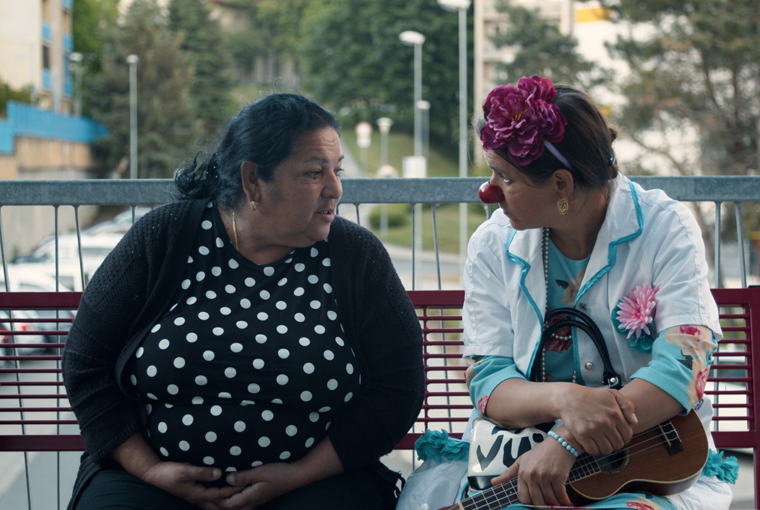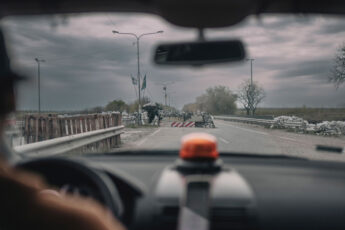At the Periphery of Otherness
Jaro Vojtek’s The Third End of the Stick (Tretí koniec palice, 2023)
Vol. 143 (March 2024) by Martin Kudláč
As one of Slovakia’s most esteemed documentary filmmakers from the so-called Generation 90 (who studied cinema and started shooting films in the 90s), Jaro Vojtek continues to distinguish himself with his latest offering, The Third End of the Stick. The film takes an intimate look at the lives of individuals within a Roma settlement, further contributing to Vojtek’s filmography that explores issues of marginalization, identity, and societal dynamics. Vojtek consistently probes the human condition through his documentary work, bringing attention to the lives of oft-overlooked communities. His previous project Shift explored the experiences of Gastarbeiter, and he has also shot a biographical documentary focusing on Slovak war journalist Andrej Bán’s battle with depression, Paradise on Earth. Vojtek is well-versed in portraying the nuanced realities of marginalized groups.
Vojtek extends his exploration into the nuances of marginalization, this time with a specific emphasis on the theme of “otherness within otherness” and the diversity of the Roma community in The Third End of the Stick. The documentary seeks to illuminate the complex lives within a Roma settlement and their broader exclusion from mainstream society. By situating the narrative within a Roma community, Vojtek not only aims to highlight the challenges faced by this group but also to confront and broaden viewers’ understanding of diversity and marginalization at large. Vojtek’s approach transcends mere documentation. He endeavors to engage with the wider implications of his subjects’ stories, addressing societal perceptions, biases, and prejudices.
Vojtek elevates voices that are often silenced, presenting a narrative that challenges viewers to re-evaluate their preconceptions about the Roma and other marginalized communities. The documentary addresses issues of identity, acceptance, and the universal search for dignity amidst ostracization. Rather than simply serving as a setting, the Roma settlements at the heart of the film are depicted as a vital presence, embodying the broader societal issues under scrutiny. The director’s deliberate focus on these communities is instrumental, bringing to the fore the experiences of a group emblematic of the broader struggles against racial and social discrimination. The cultural and social fabric of the settlement provides a critical vantage point for the film, allowing it to delve into the ramifications of social exclusion and the formidable resilience required to navigate and counter such adversity.
The documentary examines the Roma community’s struggle with stereotypes and prejudice, focusing on their efforts to navigate the complexities of identity and belonging in a society that often overlooks their experiences. Vojtek and co-writer Marek Leščák, who has written or co-penned several social realist dramas in Slovakia over the past two decades, including the award-winning Gypsy by Martin Šulík that addresses racism and segregation, opt for an episodic structure in this work. The Third End of the Stick is a portmanteau documentary featuring four chapters — Letter, Sisters, Journey, and Prayer — each revealing the struggles, aspirations, and resilience of its subjects against the backdrop of social exclusion within an already marginalized group. This approach, previously utilized by Vojtek in his anthological fiction feature debut Children, allows for a portrayal of individual experiences within the broader context of marginalization.
The film’s first chapter “Letter” introduces viewers to Jaro, a man who lost a leg at age 10 and has since navigated life on old wooden crutches for over 35 years. His modest desire for an old wheelchair underscores the harsh reality of living in the Zabijanec settlement in 2023 without electricity, a few kilometers from Spišská Nová Ves. Vojtek documents Jaro’s daily life, which involves painstakingly moving on crutches to the nearby town to request donations from local churchgoers and spending evenings playing with his young children.
The following chapter “Sisters” shifts focus to Dávid, Adrián, and Dominik, who identify more closely with female gender identities, highlighting the diversity within the Roma community in the Richnava settlement. Their story illuminates the intersection of gender identity and ethnic minority status, revealing an added dimension of “otherness” they face within their own community. This portion of the documentary emphasizes the complexity of identity and the courage required to embrace one’s real self in the face of entrenched cultural norms.
“Journey” presents the poignant story of Jarka and her 13-year-old grandson Maroš who faces a rare medical condition: he was born without an anus. The depth of Jarka’s dedication to Maroš is captured through their annual journeys to Prague for medical assessments, holding onto the prospect of a transformative surgery. This narrative underscores the strength of familial bonds and the enduring hope for a better future against the backdrop of significant medical and socio-economic challenges, with Maroš striving to experience a semblance of a normal, carefree childhood despite his condition.
“Prayer” delves into the transformative journey of Emil, a man who has overcome his past as an alcoholic and prisoner, attributing his turnaround to spiritual awakening. With Emil reflecting on his own life while witnessing his 20-year-old son tread a similarly perilous path, Emil’s story becomes one of redemption and the arduous journey towards change. This segment emphasizes the influence of parental actions on their children and the desire to escape the legacy of past errors by setting a positive example, highlighting the intricate dynamics of parental influence and the quest to alter the trajectory of generational patterns.
Vojtek’s approach to documentary filmmaking deliberately diverges from the genre’s mainstream conventions, a technique that is consistently evident in Third End of the Stick. This film eschews the traditional use of talking heads and direct testimonials to the filmmakers. Instead, Vojtek adopts a more immersive method, acting as a field filmmaker who closely follows and observes his subjects, later weaving together the footage into a coherent linear narrative that encapsulates the themes and issues he seeks to explore.
Vojtek’s prior work, Shift, employed a similar episodic structure, though it occasionally incorporated monologues or personal reflections that provided broader context to the subjects’ experiences, particularly in relation to family dynamics or to create a narrative tension by contrasting their statements with their actions as captured by the camera. However, The Third End of the Stick maintains its observational stance without these explanatory monologues, presenting only snapshots of the subjects’ lives. This approach may leave the audience feeling that the portrayal is not fully representative of the subjects’ entire existence.
“Journey” stands out in the anthology for offering a more comprehensive and representative portrayal of its subjects’ lives, largely due to its focus on two compelling protagonists and a more plot-driven approach. This segment may be considered the film’s narrative highlight, in contrast to the other three segments, which tend to remain in a sort of narrative equilibrium, offering less in the way of forward-moving storylines.
In a creative deviation from the conventional documentary technique of direct interviews, which might disrupt the viewer’s immersion, Vojtek integrates the figure of a local clown doctor. This character becomes a confidant to Maroš’s grandmother, who narrates the boy’s challenging life story, employing a similar narrative device with a specialist doctor. This method lends the film a more narrative-driven quality, emphasizing storytelling over exposition while maintaining an authentic feel. “Sisters” unfolds partially outside the Roma settlement, introducing what might be described as a group character. The segment adopts a subdued dramatic arc, focusing on personal dilemmas rather than outward plot-driven narratives, thus shifting towards psychological introspection.
By incorporating techniques typically associated with fiction, The Third End of the Stick transcends the bounds of traditional documentary filmmaking, offering a narrative that is both immersive and driven by the stories of its subjects without an overt reliance on factual exposition or historical context. Vojtek’s humanist approach avoids political overtures, thereby contributing to the film’s universal appeal. It invites audiences to engage with the challenges faced by its protagonists, who navigate life beyond societal norms. Despite its focus on personal stories, The Third End of the Stick retains an ethno-anthropological perspective that may resonate more strongly with domestic audiences familiar with the Roma community’s struggles, including cycles of generational poverty, racism, and deeply rooted segregation.




Leave a Comment